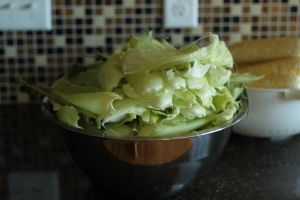One of the great things about living in Iowa is sweet corn season. A quickly grilled or boiled ear of sweet corn picked just hours earlier is one of those simple culinary treats that is hard to describe for the uninitiated. I do not even want to try lest I venture into the arena of food porn.
One of the downsides of sweet corn season and, in particular, preparing sweet corn is that fourteen ears produces a load of kitchen scraps:
It’s hard to get an idea, but that is a large mixing bowl overflowing with husks and silk. The easy answer is to compost the husks and that’s what I do.
The problem with corn husks is that the volume of material may upset the ideal balance in your compost bin. Ideally, you want to have an even balance of “green” or nitrogen rich material and “brown” or carbon rich material. The colors of the material being composted are not necessarily representative of their carbon or nitrogen content. It’s just sort of gardener shorthand.
Corn husks are a “green.” Therefore, the husks are heaping piles of nitrogen waiting to be put onto your compost pile. My compost bin tends to be heavy on the nitrogen because the primary source of material is kitchen scraps—coffee grounds, vegetable scraps, etc.
You will need to balance out the ratio of nitrogen to carbon. Luckily, you might already have the answer when you finish eating the corn because the cob is a “brown.” Throw those onto the compost pile as well. Some people swear by breaking them into smaller pieces and this will aid in decomposition, but I am a lazy composter and just throw the whole cobs onto the pile. Horror stories of eternal cobs lasting for years in active piles seem to be the stuff of garden legend. After about a year the cobs that remain are fairly well broken down.

